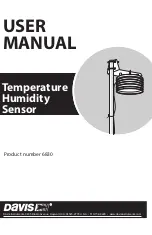
Position Control by Joystick
This system requires the position of the motor to be proportional to the joystick angle. Furthermore, the ratio
between the two positions must be programmable. For example, if the control ratio is 5:1, it implies that when the
joystick voltage is 5 Volts, corresponding to 1028 counts, the required motor position must be 5120 counts. The
variable V3 changes the position ratio.
INSTRUCTION
FUNCTION
#A
Label
V3=5
Initial position ratio
DP0
Define the starting position
JG0
Set motor in jog mode as zero
BGX
Start
#B
VIN=@AN[1]
Read analog input
V2=V1*V3
Compute the desired position
V4=V2-_TPX-_TEX
Find the following error
V5=V4*20
Compute a proportional speed
JG V5
Change the speed
JP #B
Repeat the process
EN
End
Backlash Compensation by Sampled Dual-Loop
The continuous dual loop, enabled by the DV1 function is an effective way to compensate for backlash. In some
cases, however, when the backlash magnitude is large, it may be difficult to stabilize the system. In those cases, it
may be easier to use the sampled dual loop method described below.
This design example addresses the basic problems of backlash in motion control systems. The objective is to
control the position of a linear slide precisely. The slide is to be controlled by a rotary motor, which is coupled to
the slide by a lead screw. Such a lead screw has a backlash of 4 micron, and the required position accuracy is for
0.5 micron.
The basic dilemma is where to mount the sensor. If you use a rotary sensor, you get a 4 micron backlash error. On
the other hand, if you use a linear encoder, the backlash in the feedback loop will cause oscillations due to
instability.
An alternative approach is the dual-loop, where we use two sensors, rotary and linear. The rotary sensor assures
stability (because the position loop is closed before the backlash) whereas the linear sensor provides accurate load
position information. The operation principle is to drive the motor to a given rotary position near the final point.
Once there, the load position is read to find the position error and the controller commands the motor to move to
a new rotary position which eliminates the position error.
Since the required accuracy is 0.5 micron, the resolution of the linear sensor should preferably be twice finer. A
linear sensor with a resolution of 0.25 micron allows a position error of ±2 counts.
The dual-loop approach requires the resolution of the rotary sensor to be equal or better than that of the linear
system. Assuming that the pitch of the lead screw is 2.5mm (approximately 10 turns per inch), a rotary encoder of
2500 lines per turn or 10,000 count per revolution results in a rotary resolution of 0.25 micron. This results in
equal resolution on both linear and rotary sensors.
To illustrate the control method, assume that the rotary encoder is used as a feedback for the X-axis, and that the
linear sensor is read and stored in the variable LINPOS. Further assume that at the start, both the position of X and
the value of LINPOS are equal to zero. Now assume that the objective is to move the linear load to the position of
1000.
The first step is to command the X motor to move to the rotary position of 1000. Once it arrives we check the
position of the load. If, for example, the load position is 980 counts, it implies that a correction of 20 counts must
be made. However, when the X-axis is commanded to be at the position of 1000, suppose that the actual position
Chapter 7 Application Programming ▫ 144
DMC-42x0 User Manual
Содержание DMC-42 0 Series
Страница 85: ...Chapter 6 Programming Motion 81 DMC 42x0 User Manual Figure 6 14 ECAM cycle with Z axis as master...
Страница 195: ...ICM 2900 PCB Layout Appendices 191 DMC 42x0 User Manual...
Страница 205: ...CB 50 100 Drawings Appendices 201 DMC 42x0 User Manual...
Страница 206: ...Appendices 202 DMC 42x0 User Manual...
Страница 207: ...Appendices 203 DMC 42x0 User Manual...
Страница 208: ...Appendices 204 DMC 42x0 User Manual...
Страница 209: ...Appendices 205 DMC 42x0 User Manual...
Страница 210: ...Appendices 206 DMC 42x0 User Manual...
Страница 211: ...Appendices 207 DMC 42x0 User Manual...
Страница 214: ...CB 50 80 Drawing Appendices 210 DMC 42x0 User Manual...
Страница 215: ...Appendices 211 DMC 42x0 User Manual...
















































